AUDITING AND ASSURANCE: NAB Bank Financial Statement Analysis Report
VerifiedAdded on 2023/01/05
|7
|1328
|77
Report
AI Summary
This report provides an in-depth analysis of the auditing and assurance aspects of National Australia Bank's (NAB) 2018 annual report. It identifies and assesses the key assertions at risk for three significant accounts: goodwill, accounting related to discounted operations, and fair value of financial instruments. The report examines the specific risks associated with each account, including valuation, accuracy, and existence. It also discusses the implications of the Royal Commission's findings on internal controls and risk management within major Australian banks, with a focus on NAB's efforts to improve its internal control systems. Finally, the report offers a conclusion regarding the acceptance of audit work for NAB Limited, considering the bank's reporting framework, adherence to standards, and overall risk management practices. The report evaluates the business risks and audit risks accompanied by supportive disclosures. It concludes that the audit work of NAB Limited can be accepted due to the presence of consistency in the reporting framework of the bank.
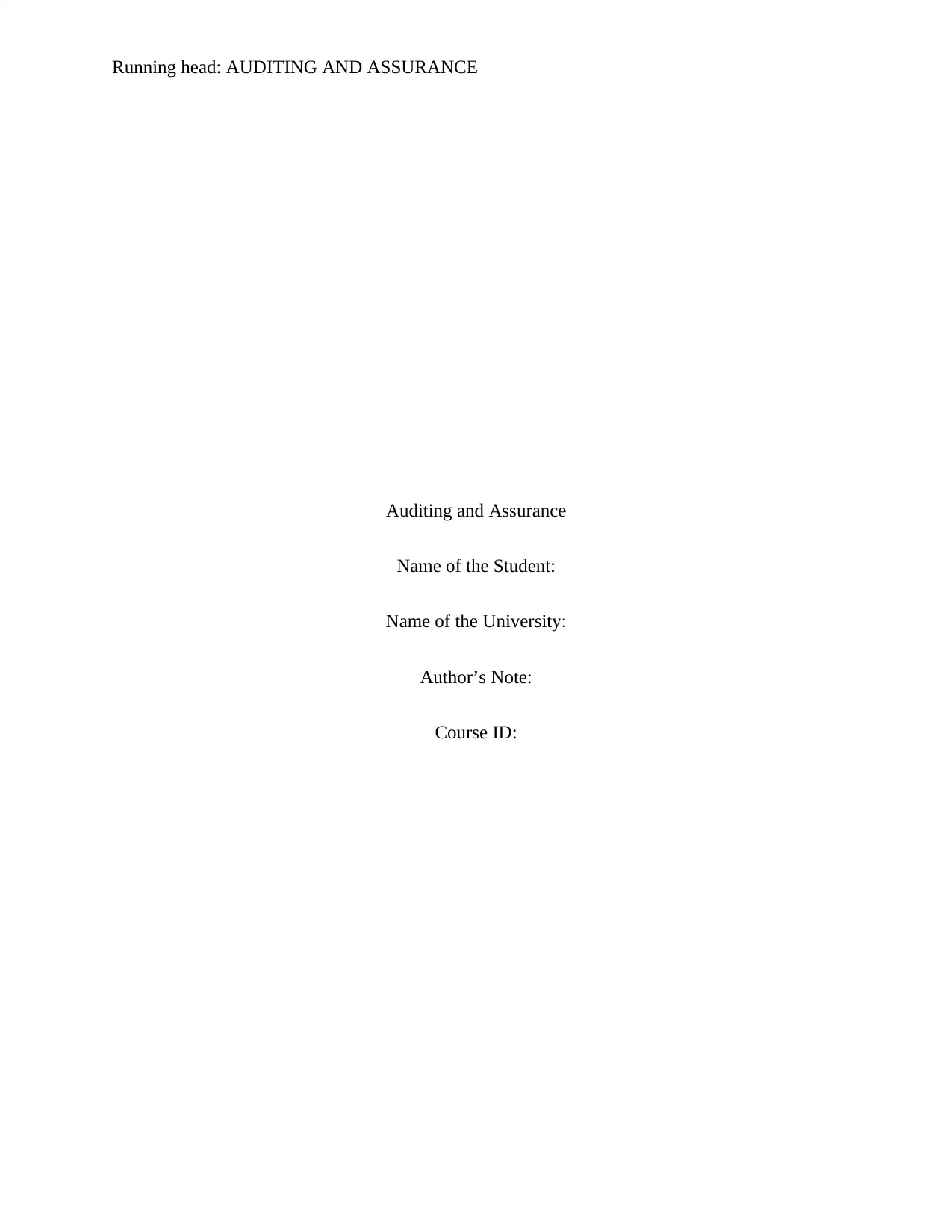
Running head: AUDITING AND ASSURANCE
Auditing and Assurance
Name of the Student:
Name of the University:
Author’s Note:
Course ID:
Auditing and Assurance
Name of the Student:
Name of the University:
Author’s Note:
Course ID:
Paraphrase This Document
Need a fresh take? Get an instant paraphrase of this document with our AI Paraphraser
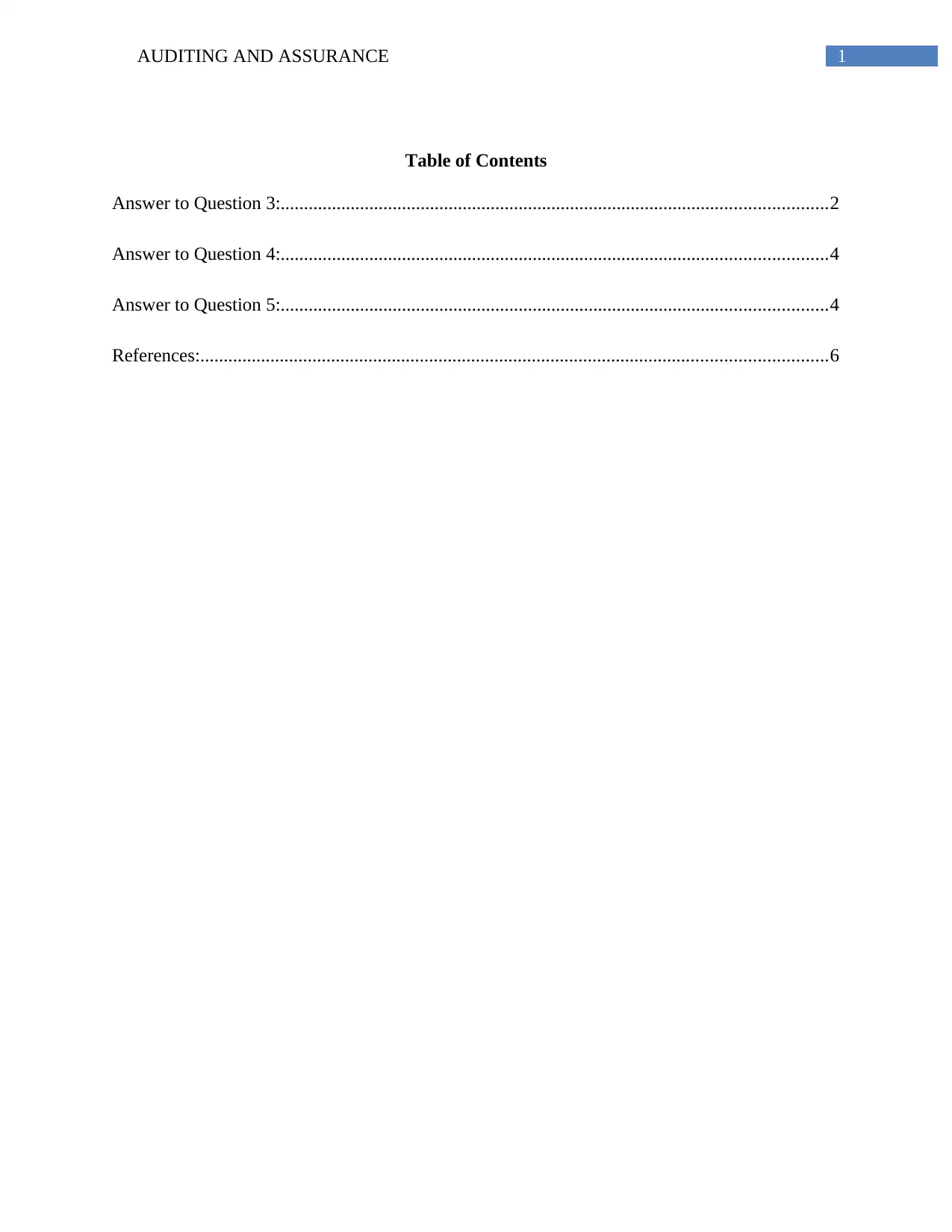
1AUDITING AND ASSURANCE
Table of Contents
Answer to Question 3:.....................................................................................................................2
Answer to Question 4:.....................................................................................................................4
Answer to Question 5:.....................................................................................................................4
References:......................................................................................................................................6
Table of Contents
Answer to Question 3:.....................................................................................................................2
Answer to Question 4:.....................................................................................................................4
Answer to Question 5:.....................................................................................................................4
References:......................................................................................................................................6
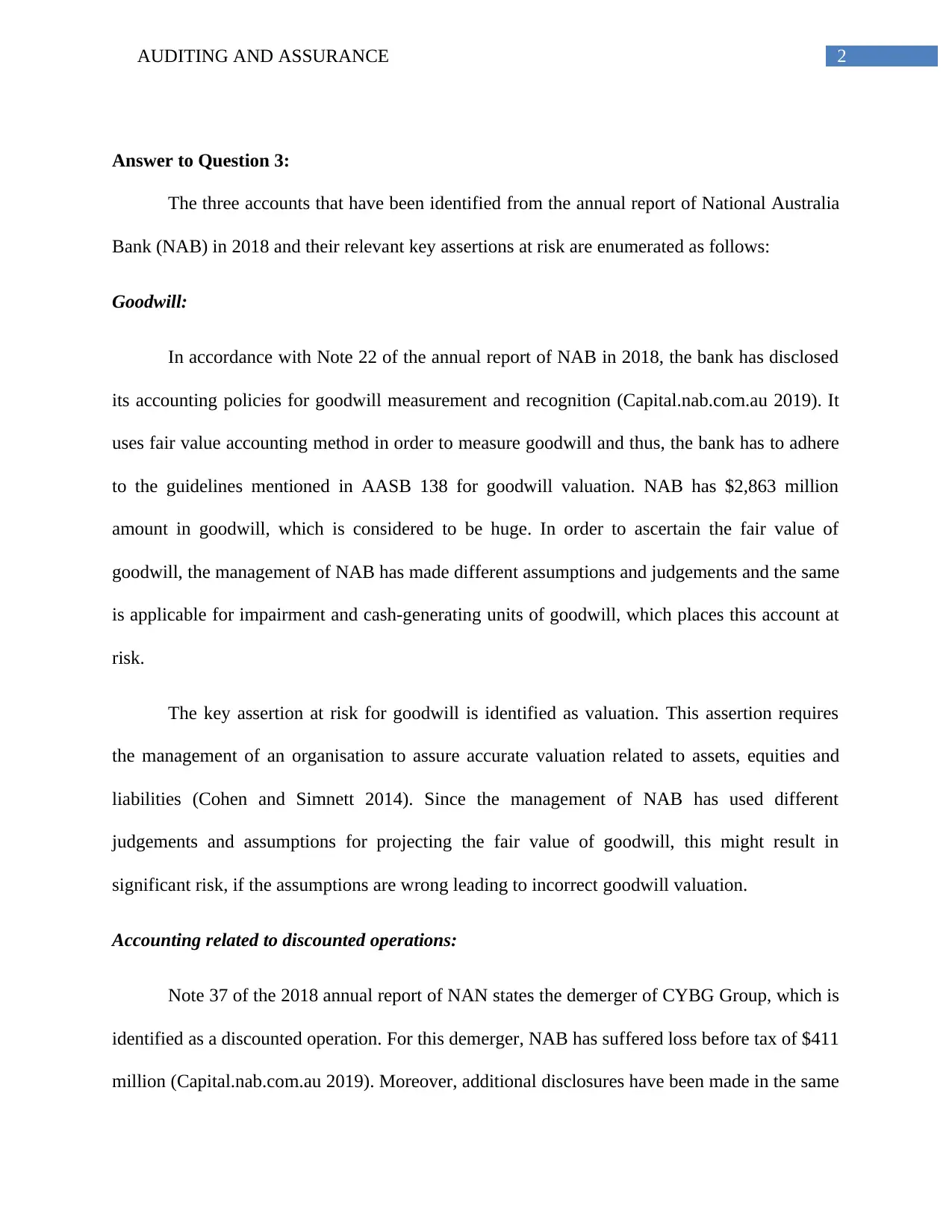
2AUDITING AND ASSURANCE
Answer to Question 3:
The three accounts that have been identified from the annual report of National Australia
Bank (NAB) in 2018 and their relevant key assertions at risk are enumerated as follows:
Goodwill:
In accordance with Note 22 of the annual report of NAB in 2018, the bank has disclosed
its accounting policies for goodwill measurement and recognition (Capital.nab.com.au 2019). It
uses fair value accounting method in order to measure goodwill and thus, the bank has to adhere
to the guidelines mentioned in AASB 138 for goodwill valuation. NAB has $2,863 million
amount in goodwill, which is considered to be huge. In order to ascertain the fair value of
goodwill, the management of NAB has made different assumptions and judgements and the same
is applicable for impairment and cash-generating units of goodwill, which places this account at
risk.
The key assertion at risk for goodwill is identified as valuation. This assertion requires
the management of an organisation to assure accurate valuation related to assets, equities and
liabilities (Cohen and Simnett 2014). Since the management of NAB has used different
judgements and assumptions for projecting the fair value of goodwill, this might result in
significant risk, if the assumptions are wrong leading to incorrect goodwill valuation.
Accounting related to discounted operations:
Note 37 of the 2018 annual report of NAN states the demerger of CYBG Group, which is
identified as a discounted operation. For this demerger, NAB has suffered loss before tax of $411
million (Capital.nab.com.au 2019). Moreover, additional disclosures have been made in the same
Answer to Question 3:
The three accounts that have been identified from the annual report of National Australia
Bank (NAB) in 2018 and their relevant key assertions at risk are enumerated as follows:
Goodwill:
In accordance with Note 22 of the annual report of NAB in 2018, the bank has disclosed
its accounting policies for goodwill measurement and recognition (Capital.nab.com.au 2019). It
uses fair value accounting method in order to measure goodwill and thus, the bank has to adhere
to the guidelines mentioned in AASB 138 for goodwill valuation. NAB has $2,863 million
amount in goodwill, which is considered to be huge. In order to ascertain the fair value of
goodwill, the management of NAB has made different assumptions and judgements and the same
is applicable for impairment and cash-generating units of goodwill, which places this account at
risk.
The key assertion at risk for goodwill is identified as valuation. This assertion requires
the management of an organisation to assure accurate valuation related to assets, equities and
liabilities (Cohen and Simnett 2014). Since the management of NAB has used different
judgements and assumptions for projecting the fair value of goodwill, this might result in
significant risk, if the assumptions are wrong leading to incorrect goodwill valuation.
Accounting related to discounted operations:
Note 37 of the 2018 annual report of NAN states the demerger of CYBG Group, which is
identified as a discounted operation. For this demerger, NAB has suffered loss before tax of $411
million (Capital.nab.com.au 2019). Moreover, additional disclosures have been made in the same
⊘ This is a preview!⊘
Do you want full access?
Subscribe today to unlock all pages.

Trusted by 1+ million students worldwide
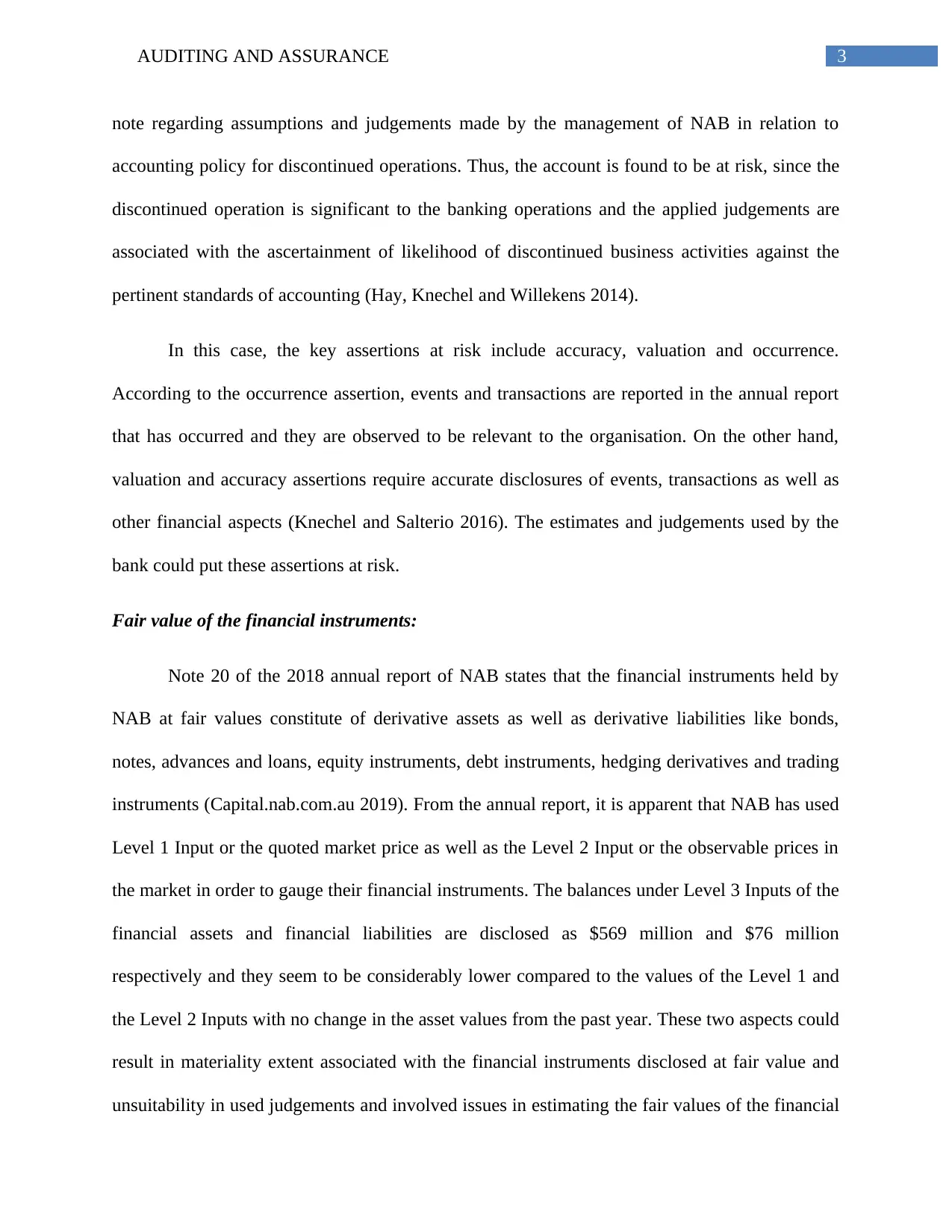
3AUDITING AND ASSURANCE
note regarding assumptions and judgements made by the management of NAB in relation to
accounting policy for discontinued operations. Thus, the account is found to be at risk, since the
discontinued operation is significant to the banking operations and the applied judgements are
associated with the ascertainment of likelihood of discontinued business activities against the
pertinent standards of accounting (Hay, Knechel and Willekens 2014).
In this case, the key assertions at risk include accuracy, valuation and occurrence.
According to the occurrence assertion, events and transactions are reported in the annual report
that has occurred and they are observed to be relevant to the organisation. On the other hand,
valuation and accuracy assertions require accurate disclosures of events, transactions as well as
other financial aspects (Knechel and Salterio 2016). The estimates and judgements used by the
bank could put these assertions at risk.
Fair value of the financial instruments:
Note 20 of the 2018 annual report of NAB states that the financial instruments held by
NAB at fair values constitute of derivative assets as well as derivative liabilities like bonds,
notes, advances and loans, equity instruments, debt instruments, hedging derivatives and trading
instruments (Capital.nab.com.au 2019). From the annual report, it is apparent that NAB has used
Level 1 Input or the quoted market price as well as the Level 2 Input or the observable prices in
the market in order to gauge their financial instruments. The balances under Level 3 Inputs of the
financial assets and financial liabilities are disclosed as $569 million and $76 million
respectively and they seem to be considerably lower compared to the values of the Level 1 and
the Level 2 Inputs with no change in the asset values from the past year. These two aspects could
result in materiality extent associated with the financial instruments disclosed at fair value and
unsuitability in used judgements and involved issues in estimating the fair values of the financial
note regarding assumptions and judgements made by the management of NAB in relation to
accounting policy for discontinued operations. Thus, the account is found to be at risk, since the
discontinued operation is significant to the banking operations and the applied judgements are
associated with the ascertainment of likelihood of discontinued business activities against the
pertinent standards of accounting (Hay, Knechel and Willekens 2014).
In this case, the key assertions at risk include accuracy, valuation and occurrence.
According to the occurrence assertion, events and transactions are reported in the annual report
that has occurred and they are observed to be relevant to the organisation. On the other hand,
valuation and accuracy assertions require accurate disclosures of events, transactions as well as
other financial aspects (Knechel and Salterio 2016). The estimates and judgements used by the
bank could put these assertions at risk.
Fair value of the financial instruments:
Note 20 of the 2018 annual report of NAB states that the financial instruments held by
NAB at fair values constitute of derivative assets as well as derivative liabilities like bonds,
notes, advances and loans, equity instruments, debt instruments, hedging derivatives and trading
instruments (Capital.nab.com.au 2019). From the annual report, it is apparent that NAB has used
Level 1 Input or the quoted market price as well as the Level 2 Input or the observable prices in
the market in order to gauge their financial instruments. The balances under Level 3 Inputs of the
financial assets and financial liabilities are disclosed as $569 million and $76 million
respectively and they seem to be considerably lower compared to the values of the Level 1 and
the Level 2 Inputs with no change in the asset values from the past year. These two aspects could
result in materiality extent associated with the financial instruments disclosed at fair value and
unsuitability in used judgements and involved issues in estimating the fair values of the financial
Paraphrase This Document
Need a fresh take? Get an instant paraphrase of this document with our AI Paraphraser
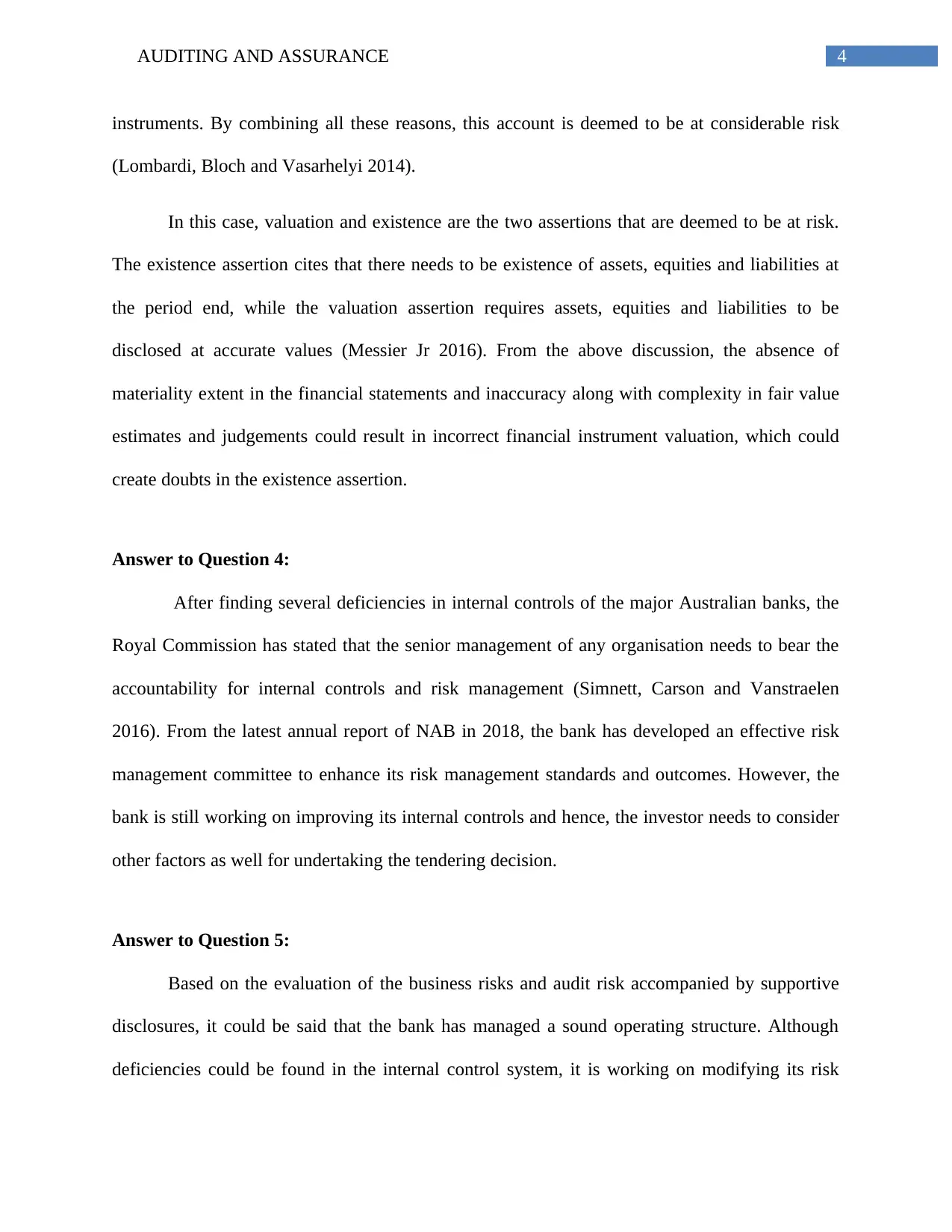
4AUDITING AND ASSURANCE
instruments. By combining all these reasons, this account is deemed to be at considerable risk
(Lombardi, Bloch and Vasarhelyi 2014).
In this case, valuation and existence are the two assertions that are deemed to be at risk.
The existence assertion cites that there needs to be existence of assets, equities and liabilities at
the period end, while the valuation assertion requires assets, equities and liabilities to be
disclosed at accurate values (Messier Jr 2016). From the above discussion, the absence of
materiality extent in the financial statements and inaccuracy along with complexity in fair value
estimates and judgements could result in incorrect financial instrument valuation, which could
create doubts in the existence assertion.
Answer to Question 4:
After finding several deficiencies in internal controls of the major Australian banks, the
Royal Commission has stated that the senior management of any organisation needs to bear the
accountability for internal controls and risk management (Simnett, Carson and Vanstraelen
2016). From the latest annual report of NAB in 2018, the bank has developed an effective risk
management committee to enhance its risk management standards and outcomes. However, the
bank is still working on improving its internal controls and hence, the investor needs to consider
other factors as well for undertaking the tendering decision.
Answer to Question 5:
Based on the evaluation of the business risks and audit risk accompanied by supportive
disclosures, it could be said that the bank has managed a sound operating structure. Although
deficiencies could be found in the internal control system, it is working on modifying its risk
instruments. By combining all these reasons, this account is deemed to be at considerable risk
(Lombardi, Bloch and Vasarhelyi 2014).
In this case, valuation and existence are the two assertions that are deemed to be at risk.
The existence assertion cites that there needs to be existence of assets, equities and liabilities at
the period end, while the valuation assertion requires assets, equities and liabilities to be
disclosed at accurate values (Messier Jr 2016). From the above discussion, the absence of
materiality extent in the financial statements and inaccuracy along with complexity in fair value
estimates and judgements could result in incorrect financial instrument valuation, which could
create doubts in the existence assertion.
Answer to Question 4:
After finding several deficiencies in internal controls of the major Australian banks, the
Royal Commission has stated that the senior management of any organisation needs to bear the
accountability for internal controls and risk management (Simnett, Carson and Vanstraelen
2016). From the latest annual report of NAB in 2018, the bank has developed an effective risk
management committee to enhance its risk management standards and outcomes. However, the
bank is still working on improving its internal controls and hence, the investor needs to consider
other factors as well for undertaking the tendering decision.
Answer to Question 5:
Based on the evaluation of the business risks and audit risk accompanied by supportive
disclosures, it could be said that the bank has managed a sound operating structure. Although
deficiencies could be found in the internal control system, it is working on modifying its risk
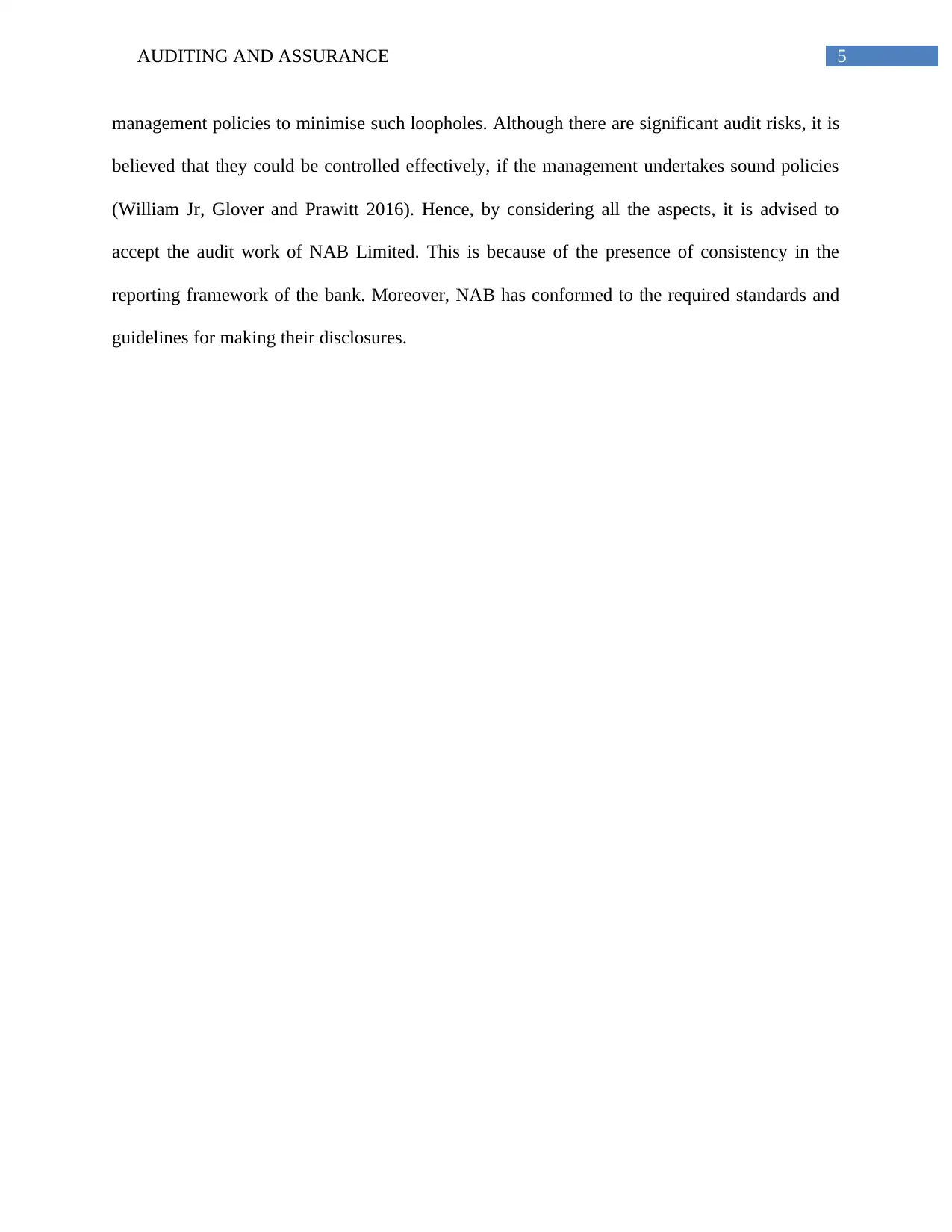
5AUDITING AND ASSURANCE
management policies to minimise such loopholes. Although there are significant audit risks, it is
believed that they could be controlled effectively, if the management undertakes sound policies
(William Jr, Glover and Prawitt 2016). Hence, by considering all the aspects, it is advised to
accept the audit work of NAB Limited. This is because of the presence of consistency in the
reporting framework of the bank. Moreover, NAB has conformed to the required standards and
guidelines for making their disclosures.
management policies to minimise such loopholes. Although there are significant audit risks, it is
believed that they could be controlled effectively, if the management undertakes sound policies
(William Jr, Glover and Prawitt 2016). Hence, by considering all the aspects, it is advised to
accept the audit work of NAB Limited. This is because of the presence of consistency in the
reporting framework of the bank. Moreover, NAB has conformed to the required standards and
guidelines for making their disclosures.
⊘ This is a preview!⊘
Do you want full access?
Subscribe today to unlock all pages.

Trusted by 1+ million students worldwide
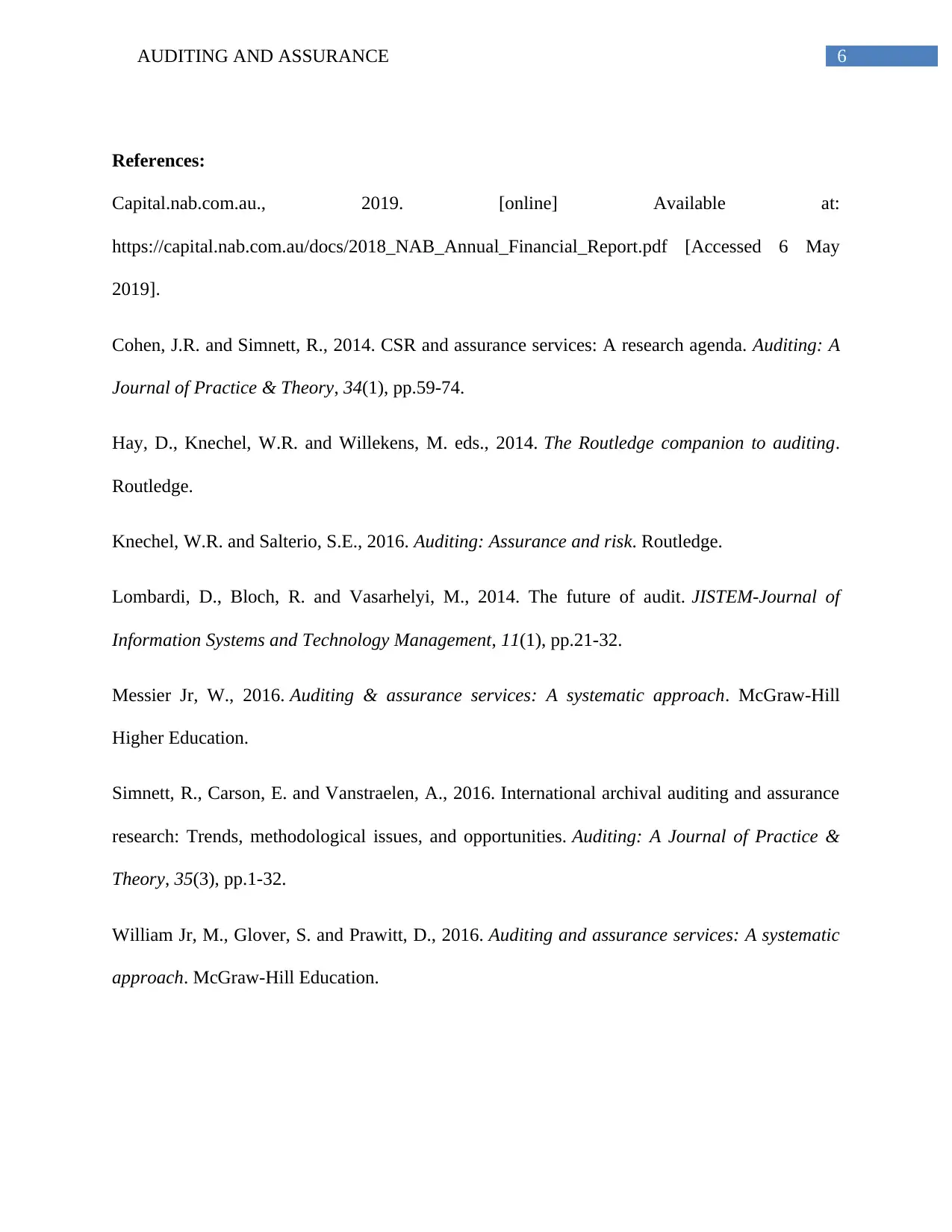
6AUDITING AND ASSURANCE
References:
Capital.nab.com.au., 2019. [online] Available at:
https://capital.nab.com.au/docs/2018_NAB_Annual_Financial_Report.pdf [Accessed 6 May
2019].
Cohen, J.R. and Simnett, R., 2014. CSR and assurance services: A research agenda. Auditing: A
Journal of Practice & Theory, 34(1), pp.59-74.
Hay, D., Knechel, W.R. and Willekens, M. eds., 2014. The Routledge companion to auditing.
Routledge.
Knechel, W.R. and Salterio, S.E., 2016. Auditing: Assurance and risk. Routledge.
Lombardi, D., Bloch, R. and Vasarhelyi, M., 2014. The future of audit. JISTEM-Journal of
Information Systems and Technology Management, 11(1), pp.21-32.
Messier Jr, W., 2016. Auditing & assurance services: A systematic approach. McGraw-Hill
Higher Education.
Simnett, R., Carson, E. and Vanstraelen, A., 2016. International archival auditing and assurance
research: Trends, methodological issues, and opportunities. Auditing: A Journal of Practice &
Theory, 35(3), pp.1-32.
William Jr, M., Glover, S. and Prawitt, D., 2016. Auditing and assurance services: A systematic
approach. McGraw-Hill Education.
References:
Capital.nab.com.au., 2019. [online] Available at:
https://capital.nab.com.au/docs/2018_NAB_Annual_Financial_Report.pdf [Accessed 6 May
2019].
Cohen, J.R. and Simnett, R., 2014. CSR and assurance services: A research agenda. Auditing: A
Journal of Practice & Theory, 34(1), pp.59-74.
Hay, D., Knechel, W.R. and Willekens, M. eds., 2014. The Routledge companion to auditing.
Routledge.
Knechel, W.R. and Salterio, S.E., 2016. Auditing: Assurance and risk. Routledge.
Lombardi, D., Bloch, R. and Vasarhelyi, M., 2014. The future of audit. JISTEM-Journal of
Information Systems and Technology Management, 11(1), pp.21-32.
Messier Jr, W., 2016. Auditing & assurance services: A systematic approach. McGraw-Hill
Higher Education.
Simnett, R., Carson, E. and Vanstraelen, A., 2016. International archival auditing and assurance
research: Trends, methodological issues, and opportunities. Auditing: A Journal of Practice &
Theory, 35(3), pp.1-32.
William Jr, M., Glover, S. and Prawitt, D., 2016. Auditing and assurance services: A systematic
approach. McGraw-Hill Education.
1 out of 7
Related Documents
Your All-in-One AI-Powered Toolkit for Academic Success.
+13062052269
info@desklib.com
Available 24*7 on WhatsApp / Email
![[object Object]](/_next/static/media/star-bottom.7253800d.svg)
Unlock your academic potential
Copyright © 2020–2025 A2Z Services. All Rights Reserved. Developed and managed by ZUCOL.





